Engage NY Eureka Math Geometry Module 2 Lesson 10 Answer Key
Eureka Math Geometry Module 2 Lesson 10 Opening Exercise Answer Key
Use a compass to mark off equally spaced points C, D, E, and F so that AB, BC, CD, DE, and EF are equal in length. Describe the steps you took.
![]()
I adjust the compass to the length of à and then place the point of the compass on B and use the adjustment to make a mark so that it intersects with the ray. This is the location of C, and i repeat these steps until I locate point F.

Eureka Math Geometry Module 2 Lesson 10 Exercise Answer Key
Exercise 1.
Divide segment AB into five segments of equal lengths.

Answer:

Exercise 2.
On a piece of poster paper, draw a segment AB with a measurement of 1 foot. Use the dilation method to divide à into twelve equal-length segments, or into 12 inches.
Answer:
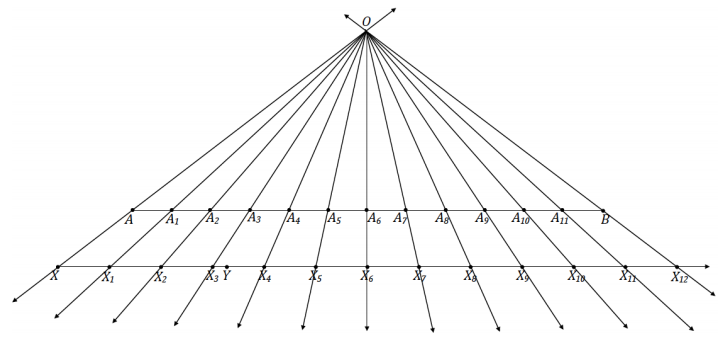
Eureka Math Geometry Module 2 Lesson 10 Problem Set Answer Key
Question 1.
Pretend you are the king or queen and that the length of your foot is the official measurement for one foot. Draw a line segment on a piece of paper that is the length of your foot. (You may have to remove your shoe.) Use the method above to find the length of 1 inch in your kingdom.
Answer:
I drew \(\overline{A B}\) representing the length of my foot. I then divided \(\overline{A B}\) into twelve equal pieces using the dilation method as follows:
I constructed \(\overleftrightarrow{D E}\) parallel to \(\overline{A B}\) and, using a compass, marked off twelve consecutive segments on \(\overleftrightarrow{D E}\) each having length DC. (Note that because \(\overline{A B}\) is a large segment, students will likely choose a length DC so that the total length of all of the segments constructed on \(\overleftrightarrow{D E}\) is noticeably shorter than AB.)
I then constructed a ray from A and B through the endpoints of the composed segment, as shown in the diagram, to form a triangle ABO. Next, I constructed \(\overrightarrow{O C}\), and then i marked its intersection with \(\overline{A B}\) point I. This distance AI is the length of 1 inch in my kingdom.
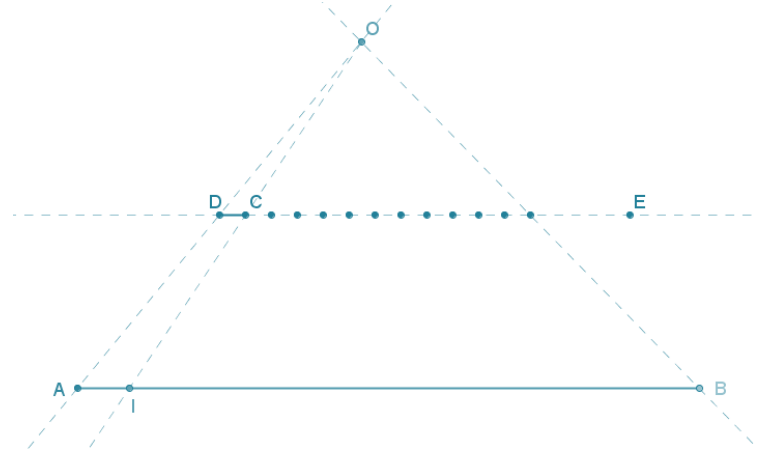
Question 2.
Using a ruler, draw a segment that is 10 cm. This length is referred to as a decimeter. Use the side splitter method to divide your segment into ten equal-sized pieces. What should be the length of each of those pieces based on your construction? Check the length of the pieces using a ruler. Are the lengths of the pieces accurate?
Answer:
Verify that students’ diagrams show the use of the side splitter method. The length of each piece should be 1 cm.
Question 3.
Repeat Problem 2 using the dilation method. What should be the length of each of those pieces based on your construction? Check the lengths of the pieces using a ruler. Are the lengths of the pieces accurate?
Answer:
Verify that students’ diagrams show the use of the dilation method. The length of each piece should be 1 cm.
Question 4.
A portion of a ruler that measured whole centimeters Is shown below. Determine the location of 5\(\frac{2}{3}\) cm on the portion of the ruler shown.

Answer:

Responses should show the segment between 5 and 6 divided into 3 equal pieces with the division point closest to 6 chosen as the location of 5\(\frac{2}{3}\).
Question 5.
Merrick has a ruler that measures In inches only. He is measuring the length of a line segment that is between 8 in. and 9 in. Divide the one-inch section of Merrick’s ruler below into eighths to help him measure the length of the segment.

Answer:
Using the side splitter method, I divided the one-inch interval into eighths, labeled as B1, B2, etc., on the diagram. The line segment that Merrick is measuring closely corresponds with B3, which represents of the \(\frac{5}{8}\) distance from 8 in. to 9 in. Therefore, the length of the line segment that Merrick is measuring is approximately 8\(\frac{5}{8}\) in.
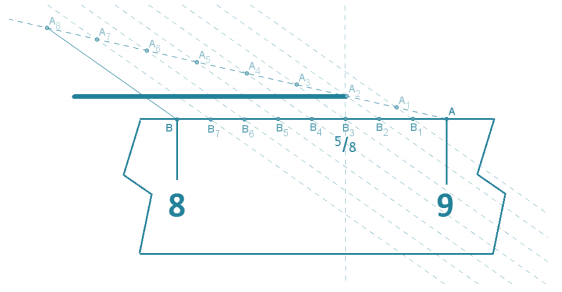
Question 6.
Use the dilation method to create an equally spaced 3 × 3 grid in the following square.

Answer:
There are several ways to complete this construction. The sample below used the dilation method along two sides of the square with centers O and O2 to divide the side into three equal-size segments. The sides of the square were extended such that DD’ = CD, CC’ = CD, BR’ = CB, and CC’1 = CB.
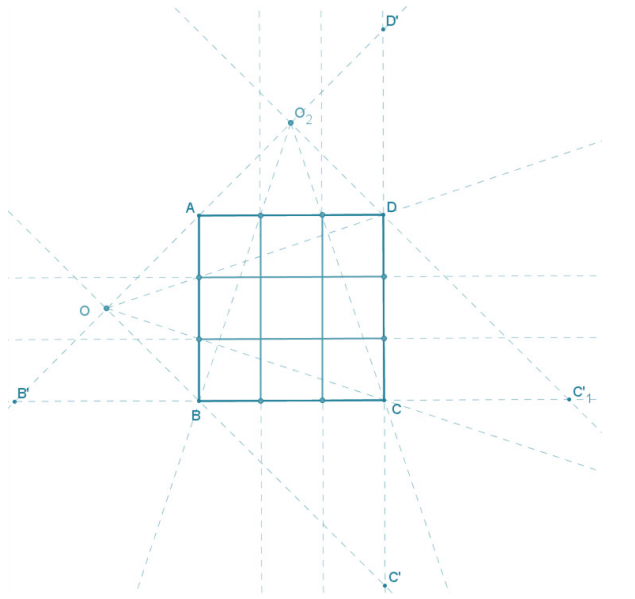
Question 7.
Use the side splitter method to create an equally spaced 3 × 3 grid In the following square.
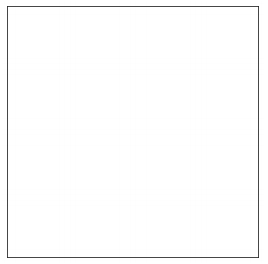
Answer:
There are several ways to complete this construction. The sample below used the side splitter method along two sides of the square to divide the side into three equal-size segments.
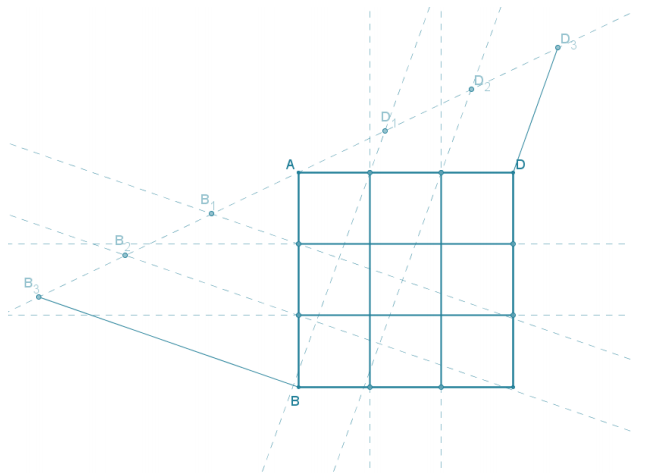
Eureka Math Geometry Module 2 Lesson 10 Exit Ticket Answer Key
Question 1.
Use the side splitter method to divide \(\overline{M N}\) into 7 equal-sized pieces.
Answer:
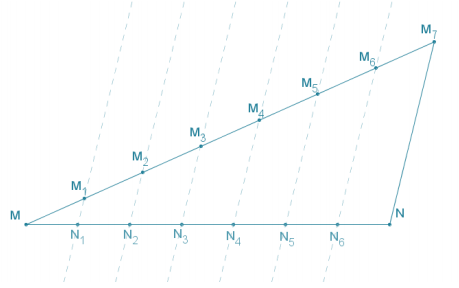
Question 2.
Use the dilation method to divide \(\overline{P Q}\) into 11 equal-sized pieces.
Answer:
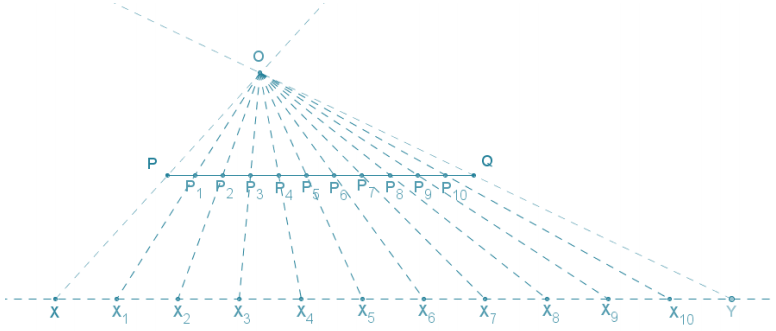
Question 3.
If the segment below represents the interval from zero to one on the number line, locate and label \(\frac{4}{7}\).

Answer:
Students may use either the side splitter method or the dilation method and need only find the location of the fourth equal-sized piece of the segment, as shown in the diagram below.

Eureka Math Geometry Module 2 Lesson 10 Exploratory Challenge Answer Key
Question 1.
Divide segment AB into three segments of equal lengths.
![]()
Answer:
Draw each step of the Exploratory Challenge so that students can refer to the correct steps whether they are ahead or
working alongside the teacher.
→ Pick a point A1 not on \(\overline{A B}\). Draw \(\overrightarrow{A A_{1}}\).

→ Mark points A2 and A3 on the ray so that AA1 = AA2 = A2A3.
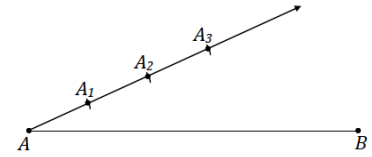
→ Use a straightedge to draw \(\overline{A_{3} B}\). Use a set square to draw segments parallel to \(\overline{A_{3} B}\) through A1 and A2.
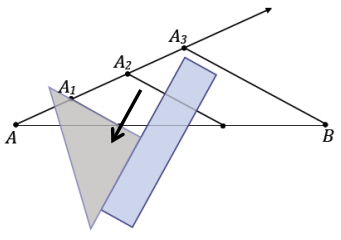
→ Label the points where the constructed segments intersect \(\overline{A B}\) as B1 and B2.

Allow students time to discuss with each other why the construction divides AB into equal parts.
→ Did we succeed? Measure segments AB1, B1B2, and B2B. Are they all equal in measurement?
→ After the last step of the construction, answer the following: Why does this construction divide the segment AB into equal parts?
Allow students a moment to jot down their thoughts, and then take responses.
→ By construction, segments A1B1 and A2B2 are parallel to segment A3B3. By the triangle side splitter theorem, \(\overline{A_{1} B_{1}}\) and \(\overline{A_{2} B_{2}}\) are proportional side splitters of triangle ABA3. So, \(\frac{A B_{1}}{A B}=\frac{A A_{1}}{A A_{3}}=\frac{1}{3}\) and \(\frac{A B_{2}}{A B}=\frac{A A_{2}}{A A_{3}}=\frac{2}{3}\). Thus, AB1 = \(\frac{1}{3}\)AB and AB2 = \(\frac{2}{3}\)AB, and we can conclude that B1 and B2 divide line segment AB into three equal pieces.
Question 2.
Divide segment AB into four segments of equal length.
![]()
Answer:
→ Use the set square to create a ray XY parallel to \(\overline{A B}\). Select the location of the endpoint X so that it falls to the left of A; the location of Y should be oriented in relation to X in the same manner as B is in relation to A. We construct the parallel ray below \(\overline{A B}\), but it can be constructed above the segment as well.
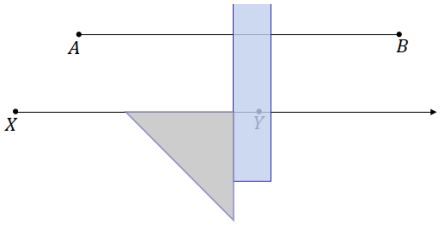
→ From X, use the compass to mark off four equal segments along \(\overrightarrow{X Y}\). Label each intersection as X1, X2, X3, and X4. It is important that XX4 ≠ AB. In practice, XX4 should be clearly more or clearly less than AB.

→ Draw line XA and line X4B. Mark the intersection of the two lines as O.
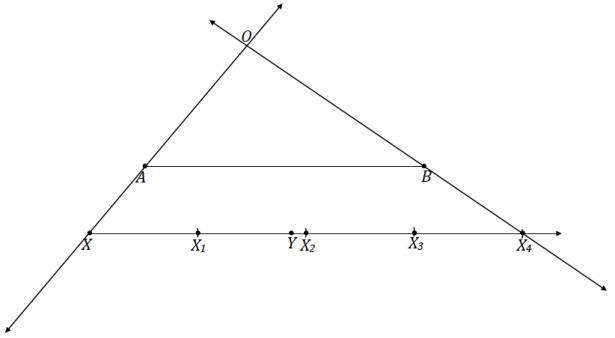
→ Construct rays from O through X1, X2, and X3. Label each intersection with \(\overline{A B}\) as A1, A2, and A3.
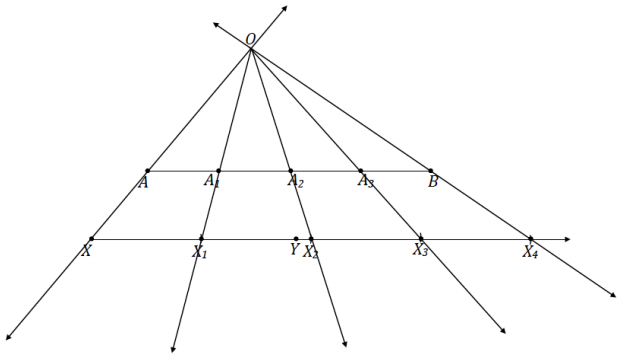
→ \(\overline{A B}\) should now be divided into four segments of equal length. Measure segments AA1, A1A2, A2A3, and A3B. Are they all equal in measurement?
→ Why does this construction divide the segment AB into equal parts?
Allow students time to discuss with each other why the construction divides \(\overline{A B}\) into equal parts.
We constructed \(\overline{A B}\) to be parallel to \(\overrightarrow{X Y}\). In ∆ X OX4, since the side splitter \(\overline{A B}\) is parallel to \(\overline{X X_{4}}\), by the triangle side splitter theorem, it must also be a proportional side splitter. By the dilation theorem, this means that \(\frac{A A_{1}}{X X_{1}}=\frac{A_{1} A_{2}}{X_{1} X_{2}}=\frac{A_{2} A_{3}}{X_{2} X_{3}}=\frac{A_{3} B}{X_{3} X_{4}}\). Since we know that the values of all four denominators are the same, the value of all four numerators must also be the same to make the equation true.
Therefore, \(\overline{A B}\) has been divided into four segments of equal length.
→ We call this method of dividing the segment into equal lengths the dilation method, as the points that divide \(\overline{A B}\) are by definition dilated points from center O with scale factor r = \(\frac{O A}{O X}\) of the evenly spaced points on \(\overrightarrow{X Y}\).

→ What happens if line segments XX and AB are close to the same length?
The point O is very far away.
→ That is why it is best to make XXn clearly more or less than AB. It is also best to keep line segments XXn and AB centered, or the point O will also be far away.